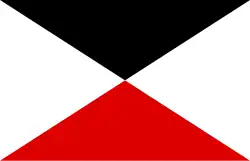I Cavalry Corps (German Empire)
| I Cavalry Corps (Höhere Kavallerie-Kommando Nr 1) Higher Cavalry Command No. 1 | |
|---|---|
 Flag of the Staff of a Generalkommando (1871–1918) | |
| Active | 2 August 1914-3 March 1918 |
| Disbanded | 1919 |
| Country | |
| Branch | Army |
| Type | Cavalry |
| Size | Approximately 13,000 (on mobilisation) |
| Engagements | World War I |
| Insignia | |
| Abbreviation | HKK 1 |
The I Cavalry Corps (German: Höhere Kavallerie-Kommando 1 / HKK 1 literally: Higher Cavalry Command 1) was a formation of the German Army in World War I. It was formed on the mobilization of the German Army in August 1914 and disbanded in March 1918.
I Cavalry Corps
The Corps initially served on the Western Front with the Guards and 5th Cavalry Divisions and preceded the 3rd Army.[1] By 15 September 1914, it was assigned to 2nd Army and comprised the Guards and 2nd Cavalry Divisions.[2] Transferred to the East on 6 November 1914[3] and attached to the 9th Army. By 8 February 1915, it consisted of the 6th and 9th Cavalry Divisions.[4]
At various times, the Corps was named for its commander as Cavalry Corps Richthofen, Corps Richthofen and Army Group[5] Richthofen.
It remained with 9th Army until 20 November 1916, when it was redesignated as 56th Corps (z.b.V.).[6][7]
56th Corps
56th Corps (z.b.V.)[8] was formed on 20 November 1916 by the redesignation of I Cavalry Corps.[9] As the need for large mounted cavalry formations diminished as the war went on, the existing Cavalry Corps increasingly took on the characteristics of a normal Corps Command. This culminated in them being redesignated as "General Commands for Special Use" Generalkommandos zur besonderen Verwendung (Genkdo z.b.V.). 56th Corps was disbanded on 5 March 1918.[10]
Order of Battle on mobilisation
Initially, the Corps simply consisted of 2 Cavalry Divisions (with 3 Jäger battalions attached) without any Corps troops; in supply and administration matters, the Cavalry Divisions were entirely autonomous. The commander was only concerned with tactics and strategy, hence his title of Senior Cavalry Commander Höherer Kavallerie-Kommandeur.[11]
On formation in August 1914, the Corps consisted of:[12]
- Guards Cavalry Division
- 5th Cavalry Division
- 11th Jäger Battalion
- 12th Jäger Battalion
- 13th Jäger Battalion
Each cavalry division consisted of 3 cavalry brigades (6 regiments each of 4 squadrons), a horse artillery Abteilung (3 four-gun batteries), a machine gun detachment (company size, 6 MGs), plus pioneers, signals and a motor vehicle column. A more detailed Table of Organisation and Equipment can be seen here. The Jäger battalions each consisted of 4 light infantry companies, 1 machine gun company (6 MGs), 1 cyclist company and a motorised vehicle column.[13]
Commanders
I Cavalry Corps / 56th Corps had the following commanders during its existence:[14][15][16]
| Commander | From | To |
|---|---|---|
| General der Kavallerie Manfred Freiherr von Richthofen | 2 August 1914 | 23 September 1916 |
| General der Kavallerie Götz Freiherr von König | 23 September 1916 | 5 March 1918 |
See also
- German Army (German Empire)
- German Army order of battle (1914)
- German cavalry in World War I
- TOE, German Cavalry Division, August 1914
References
- ^ Cron 2002, p. 299
- ^ Ellis & Cox 1993, p. 176
- ^ Cron 2002, p. 94
- ^ Ellis & Cox 1993, p. 189
- ^ Armee-Gruppe in the sense of a part of an army formed for a specific task. Heeresgruppe is an Army Group in the sense of a number of armies under a single commander.
- ^ General Commands for Special Use Generalkommandos zur besonderen Verwendung (Genkdo z.b.V.)
- ^ Cron 2002, p. 95
- ^ Note that Corps (z.b.V.) were designated with Arabic, not Roman, numerals.
- ^ Cron 2002, p. 89
- ^ German War History Accessed: 13 April 2012
- ^ Cron 2002, p. 94
- ^ Cron 2002, p. 299
- ^ Cron 2002, p. 116
- ^ The Prussian Machine, HKK Accessed: 20 May 2012
- ^ The Prussian Machine, GenKdo Archived 2012-06-30 at archive.today Accessed: 20 May 2012
- ^ German War History Accessed: 20 May 2012